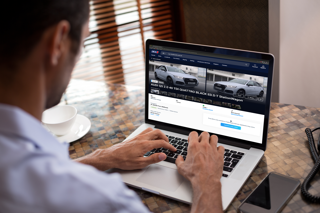The mere existence of a website doesn’t guarantee its effectiveness, so how can motor retailers ensure that the web is working for them? Craig Thomas sought the experts’ best practice tips
1: How analytics can help
The key to a successful website is understanding who uses it, how they get there and what they do when they get there. The tool that enables dealers to do that is Google Analytics.
Paul Hilton, retail director at web agency GForces, said: “Google Analytics is a really powerful tool for motor retailers to use when it comes to understanding how traffic gets to their website, what users do when they’re in the website, what pages they come in on, what pages they leave on, etc. It’s really powerful for them to use it for that purpose.
“For example, social media is now becoming a really important traffic driver for dealers and another trend we’re seeing is that less traffic is being referred from portals such as AutoTrader and eBay Motors.”
Ian Godbold, marketing director for Cambria Automobiles, is a fan of Google Analytics.
He said: “We completely transformed our marketing mix and campaigns on the back of what Google Analytics was telling us. And we set up a number of goals on our website. Did they reach the search results page? Did they reach the vehicle detail page? And then a number of goals of what they did on that vehicle detail page. Did they watch a video? Did they click on, to get a sale price? We were able to track all those, and track engagements and conversions.”
Martin Dew, digital solutions director for web agency Autoweb Design, said: “The important thing is that dealers need to understand that people could potentially come to their website from a range of different search queries. So, for example, somebody searching for the dealership’s name, or even the franchise and the location.
“The first thing is to have a proper Google Analytics set-up. If you have a dealership website, you need to invest some time, probably with an agency, to get things set up, like tracking of inquiries, grouping of audiences based on where they come from, and grouping of different content.”
2: Ask your users
The best way of ensuring that your website is accessible and easy to use is to test it with the likes of user clinics or software that can track a user’s journey.
Alex Humphries, from web agency My Social Agency, said: “User experience is an incredibly important part of a website, and it can make or break whether a customer comes to you or not when looking for a car. Tools such as Hotjar can generate heatmaps of where users have clicked, or where they have scrolled, so you can begin to get an idea of what is appealing to site visitors and what is not.”
Dew added: “User testing, and user experience testing, is very important, because how your website works and feels will affect how somebody feels about your brand, and how likely they are to do business with you.”
Hilton said: “My advice to dealers would be to just go through journeys yourself. There are so many examples where dealers just simply don’t look at their website, particularly on mobile, because they’ll tend to look at it on their work PC.
“Often, just looking at the way your site works and comparing your experience to the same experience you would get on consumer websites, such as John Lewis or Amazon, you can spot things that intuitively you know are not right for the customer experience.”
3: Always audit
The experts AM spoke to were unanimous about the need for dealers to audit their websites regularly.
Godbold said: “Every single month, we run through an audit – a full crawl on our site. We give the results to our technical guys and they just fix whatever needs to be made right.”
Dew said: “Doing your own monthly audits in-house, and things like technical SEO housekeeping, that’s just good practice. And if there’s no resource to do it within the dealership, then you can normally find an agency that will do that housekeeping work.”
Hilton added: “It’s just using common sense. Look at the journey. If I want to land on your site to find your telephone number, how many clicks do I have to make before I see somebody’s telephone number? If it’s more than one, something needs to be done about it.
“A website is never finished, and we try and engender that spirit into our customers that whatever we do with this site, we have to continually look at it and evolve it.”
4: The dark arts of SEO
Search engine optimisation (SEO) is the process of getting traffic from the results on search engines. It’s the key to ensuring that consumers see your site ranked early among their search results.
Hilton explained why SEO is important: “It’s for website providers to make sure that their platform is structurally sound to react to those algorithm changes. A lot of it can be content-orientated or things that dealers can control. And then a lot of it needs the technical implementation from the provider of that platform.
“A lot of SEO now is about content. The biggest thing we tell dealers is that they need authoritative content. You can’t copy your new car pages from your manufacturer website. That is not content that Google will identify as being yours. You have to treat SEO as a channel for marketing, but you have to focus on your content and make sure your web provider is focusing on the technical things that are beyond your control.”
Dew said: “Quite often, a lot of the organic search traffic on a dealer website comes from their dealership brand name. As search volumes vary through time, this means organic search traffic isn’t always the right indicator of how well you are doing with SEO. It is important not only to look at traffic but to monitor your rankings for your target keywords using SEO tools, or an SEO agency. It’s also a good idea to be plugged into the SEO community via an agency.”
Humphries said a recent change in SEO algorithms was particularly significant: “In March, Google announced that the mobile-first index was being implemented. Being mobile-first means that dealer websites work effectively on mobile devices, by designing it for mobile before designing it for the desktop. It’s about keeping in touch with changes in technology and consumer behaviour, to ensure that you don’t miss a potential test drive or sale.”
5: Informing customers
It is vital that motor retailers use their websites to keep customers informed about important regulatory issues, such as the change to published fuel economy figures after the switch to WLTP testing.
Hilton said: “It’s important to provide content within your website to make sure consumers understand that you are taking these things seriously.
“For WLTP, we’ll be creating sections within dealer websites. Infographics are a great way of doing that – if you look on WLTPFacts.eu, there’s a really good infographic there. creating content that breaks down barriers between what the consumer sees in the news about WLTP and dealers being able to explain simply what it is.”
Dew said providing this information in a clear way also helps a dealership’s credibility with consumers: “It impacts on things like inquiry rates from the website, which is our ultimate goal, in practice – and looking professional and trustworthy, and building trust with people.
“I think with anything like WLTP, where it is a big news story, it’s important to think about how you present things, from a branding perspective. But clearly transparency, honesty and helpfulness all help to build trust, which is important when it comes to turning a visitor into an inquiry.” CRAIG THOMAS

















Login to comment
Comments
No comments have been made yet.